|
FAQs about the Damselfish
Identification
Related Articles: Damselfishes, Clownfishes, Jumbo
Damselfishes,
Related FAQs: Clownfish
Identification, Damsels 1,
Damsel Systems, Damsel Selection, Damsel Behavior, Damsel Compatibility, Damsel Feeding, Damsel Disease, Damsel Reproduction,
Neoglyphidodon oxyodon
(Bleeker 1858), the most commonly named
"Jewel Damsel". Photo by Hiroyuki Tanaka.
|
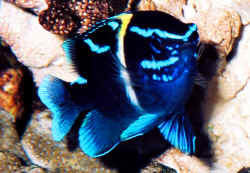
|
|
Fish Identification 7/13/17
Hello WWM crew,
<Peggy>
I’m considering purchasing the largest fish shown in the attached photo from my
LFS but have searched for specific id on this fish to no avail. I’ve looked
through your site in an effort to identify him but did not see him. He appears
to be a damsel of some sort but because there are a ton of them with varying
personalities I want to be certain of his behavior before I buy him for my reef
system.
<Is for sure a Damsel; Pomacentrid>
In the shop he’s peaceful and appears to get along well with tankmates but we’ve
all been down that road. Thanks for your help. I appreciate it. Please pardon
the appearance of their tank. They typically do a pretty good job of maintenance
even though they unfortunately don’t know much about any of the marine fish or
reef animals they carry. I’ve rescued a few from them but overall they do pretty
well at keeping their parameters consistent and keeping their fish healthy.
Corals, well, that’s another story.
Thanks so much. I appreciate any information you can provide on this beautiful
fish.
Peg
<I think this fish may be a Dischistodus prosopotaenia (Bleeker
1852), the Honey-Head Damsel. A hardy genus, but can be tough on tankmates;
needs room, regular feeding. Bob Fenner>
|
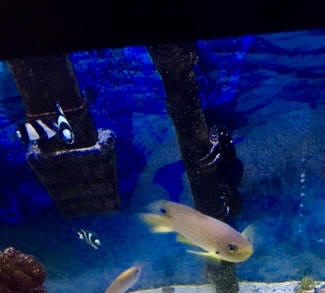 full size pic
full size pic |
|
Re: Fish Identification 7/13/17
Hi Bob,
<Peg>
Wow! Lightning speed on your response! Greatly appreciated. Based on the photos
I’m seeing of the Honey Head, I don’t see the resemblance? Is there a chance the
one in my photo from the LFS is an immature version or?
<I think this is an adult... see WWM:
http://www.wetwebmedia.com/dischistodus.htm
Any other ideas? Thanks so much!
<Another Damsel species....! BobF>
Re: Fish Identification 7/13/17
Thanks Bob. I checked out the link and see what you mean! Hope I didn’t
offend you with my second inquiry.
<Oh no; not to worry. All my IDs are tentative... am always glad to receive
corrections, input>
Surely not my intention. I’ve been pondering this fish and its purchase for a
couple weeks now and appreciate your help and will therefore be leaving this
fish right where he is! Many thanks again. Peggy
<As many welcomes. B>
|
|
Damsels ID 6/20/16
Hi, crew :) . I wanted to see if y'all could help me identify these two
species of damselfish... I can't find anything on them on the internet.
Thanks.
<Need better resolved pix; but DO take a look on Fishbase.org for
the family (Pomacentridae): the species pictured on the family page/link. Or
Gerald Allen's survey works of the family. Bob Fenner>
|
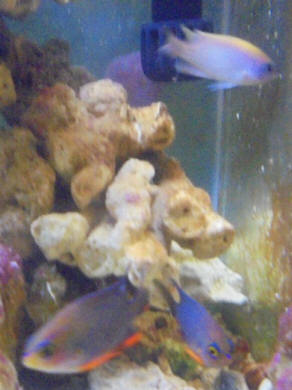 |
Banggai Damselfish Amblypomacentrus clarus
1/22/15
Hello hello! Got a damselfish question for you (and for a change it's
not 'can you identify this damselfish' type question). I will freely
admit, damsels are my favorite SW fish (my fave FW fish are livebearers,
guess I just have common tastes!).
<Heeee! But good, diverse ones!>
So when a new batch of "assorted damsels" comes in I always check them
out to see if anything interesting has arrived. This past week I found
two beauties, a Staghorn damsel (Amblyglyphidodon curacao) and a Banggai
Damselfish (Amblypomacentrus clarus).
Apparently the Banggai Damsel was fairly recently discovered and most of
what I can find online is scientific in nature. While that's useful in
its own way I'm really looking for more general care information,
compatibility, adult size, etc. Any useful information you can pass
along to me will be greatly appreciated!
Thank you,
Joanne
<Wish I had some to impart (I don't)... Would imagine its care would be
similar for its congeners, but I have little experience (have only seen
A. breviceps briefly in captivity and the wild). Appears to be a
skittish, singular species; not too mean (more like Pomacentrus or
Chrysiptera let's say rather than Stegastes or Dascyllus... is it
aquarium-hardy? Again, I don't know. Perhaps you will contribute to its
captive husbandry notes. Bob Fenner>
Re: Banggai Damselfish
Amblypomacentrus clarus; and damsel ID 1/23/15
Thanks! There seem to be a number of papers in Japanese about this fish, which
doesn't do me any good.
<There's highly likely more available via a computerized bibliographic search
(there's a bit re this on WWM); but again, I doubt if it pertains to practical
husbandry matters>
My identification as A. clarus rather than A. breviceps is based on the lack of
yellow coloration and the sharpness of the markings. So it is possible that the
colors will change a bit as the fish settles in but I'm pretty sure of the ID.
<Ok>
My fish is very small, clearly a juvenile, so there does not seem to be a
juvenile/adult color shift in this species. Actually I was lucky to ID this one
so quickly as there is so little online about these.
<Have most all G. Allen's Pomacentrid works, and look more than once/mo on
Fishbase.org re the family. The species count is nearing four hundred... and
some species in the same and different genera appear quite similar>
Although tiny, he seems to be doing well. Any food that goes into the tank is
eaten. He's fairly bold, stays out in the open and doesn't dart away when I am
nearby. He's in the same tank as the Staghorn damsel as they came from the same
tank in the store and I got them only a few days apart.
So far neither fish has shown any aggression toward the other.
The Staghorn damsel was quite a surprise. He had been at the pet store for a
number of weeks as he looked kind of dorky and homely and no one would by him.
The juvenile form of A. curacao is not very graceful, to say the least, and at
the store he displayed a rather washed out, dull silver coloration.
<I believe I relate my personal endeavours in making the genus
Amblyglyphidodon popular in the hobby in a piece archived on WWM. Nice
animals, not widely used>
After several weeks at the store he was showing signs of being bullied by some
of the more aggressive damsels and since I have a weakness for damsels (and also
an unoccupied tank) I took him home. Imagine my surprise when the next day he
looked like a different fish! Nighttime coloration has bars like the adult fish,
daytime coloration is similar to a green Chromis.
Very pretty! I'm sure of the genus for this guy but may have to wait until he
matures to be certain of the species ID as there seems to be a lot of color
variation in this group.
<There are and have been a few "new/old" discoveries of "intra" species in
recent years>
And, um, can I go ahead and ask you a "can you identify this damselfish"
question? There was a third damsel (at the same store no less) that I had never
seen before so of course that one came home too. That was quite a damsel
shipment they got in, three species I hadn't ever seen in a store!
Anyway, coloration on this fish is very very similar to a Talbot's damsel.
Same violet pink on the lower part, yellow on the upper, but it's not a
Talbot's. There are none of the small blue markings, there is no dorsal spot,
and the yellow area does not extend down over the face or pelvic fins.
<I'd have you look on Fishbase... starting with the family:
http://www.fishbase.org/summary/FamilySummary.php?ID=350
Then click on the blue/link at bottom left (Show species images); and do the
long scroll... If you'd like, starting w/ (in alphabetical order) the genus
Chrysiptera... Otherwise, PLEASE send along well-resolved pix>
There is a tiny tiny black dot just behind the gill covers. The fish is not as
deep-bodied as a Talbot's, and it moves more swiftly. I can't find a picture in
FishBase or anywhere else online, or in my "Damselfish of the World" and
"Damselfishes & Anemonefishes" books. Behavior is typical damsel, not really
aggressive but certainly not shy. Any clues on this one?
<... only a guess, but perhaps C. rex.... >
Thanks again!
Joanne
<Welcome. Bob Fenner>
FW: Banggai Damselfish Amblypomacentrus clarus P.S. - forgot to
mention, all of the other damsels at this store were
Indo-Pacific so the unidentified on should be from the same location.
<Ah yes; most species hale from this part of the world period, and most all used
in the trade in the West are Indo-Pac. BobF>
Chromis ID
4/20/14
Hi Bob (or whoever I get! :D)! First I wanted to say thank you many
times over for all of the times you've answered panicky questions about
our poor fish (rabbit in a dire way). You and everyone else on
WetWebMedia are, quite frankly, our heroes just in terms of helping us
retain our sanity over the years.
Today I actually just have a simple question. Our tank is doing well
(yay!), our fish are all fat, happy, healthy, and getting along (with
one exception and he is now living in the sump until he can be rehomed
into our upcoming non-fowlr tank). We acquired two very pretty Chromis
(identified as yellow Chromis)
<Not this genus>
and a sergeant major damsel. All three beautiful fish, all three
aggressive enough to survive our tank (until the larger Chromis decided
the smaller was easy pickings so the littlest guy is in the sump happily
getting fat). The problem is, I don't think these guys are actually
yellow Chromis. I can't find a picture anywhere online that actually
looks like them. The darker color variant of the yellow does look
similar but not really close enough, in my opinion.
They are a purplish-brown with a deep yellow-orange anal fin and rear
belly area. The caudal fin and dorsal fins are not yellow. They also
have a dot of yellow at the base of their pectoral fins. Thing one (the
larger) is probably about 3 1/2" and growing. Thing two is about an inch
smaller but otherwise identical. I have only seen Chromis that looked
like them one other time and that was in the Wild Reef at the Shedd
Aquarium in Chicago.
Unfortunately it was one of the only fish they didn't have listed and it
was in one of the "big" tanks. I've included a video (he won't hold
still for a not-blurry picture, the little booger).
Thanks!! Carole :)
<Try looking (and clicking on) the members of the family on
Fishbase.org:
http://www.fishbase.us/identification/specieslist.php?famcode=350&areacode=
Bob Fenner>
Re: Chromis ID 4/21/14
Thanks Bob. I have searched FishBase (it's one of my go-to sources when
I'm trying to identify fish) and I'm not seeing anything that
really looks like my guys. The closest is the
*Chromis atripes (*
http://www.fishbase.us/Photos/ThumbnailsSummary.php?ID=4982)
and as mine
don't have that distinctive dark edging on their fins I'm thinking
that's not it either (though the yellow spots
at the pectoral fins is kinda "fishy"). I
think my next step will be to wander into the Shedd (I work a
few miles north of the Shedd and am also a member so it's not a
big "out of the way" trip) and see if I can't
hunt down someone who can tell me. I love
FishBase though I'm very sad I can't find what I'm looking for on
there. It also just occurred to me that the video may not work on
a regular
computer (it doesn't on my work computer) so I'll see if I can't get
Thing One to sit still long enough for a
better picture. :)
Thanks!
Carole
<Strange; but I didn't find a good match either... The genus
Amblyglyphidodon is the closest I'm at currently.
Please do send on any further ID. BobF>
Re: Chromis ID 4/27/14
Hi Bob!!
<Hey Carole>
I'm sorry it took so long to get back with this. Today's the first day I
had time to stop in at the Shedd. So, my little guys are in FishBase
after all. The reason we had a hard time is because they are a different
color morph than what appears in FishBase. They are
Neoglyphidodon nigroris (sorry about the lack of italics - I
haven't figured out if the iPhone can do them yet). When I look at them
in FishBase I can see it. I just overlooked them previously because the
colors didn't match. Being a different color morph makes sense. Here's a
link to their page on FishBase.
http://www.fishbase.us/summary/Neoglyphidodon-nigroris.html
<Really? Am looking at your post on WWM:
http://wetwebmedia.com/damselidfaqs.htm
Mmm, Okay>
Thanks for your help as always!!
Carole
<Thank you for this follow-up. BobF>
Damsel ID 9/27/13
Hi Bob,
I have attached a picture
<<Someone else's work>> of a damsel I have seen a few times in the past
and today in my LFS here in the UK. It was labeled as a
tricolour damsel, Chrysiptera rollandi .
It doesn't look like the Chrysiptera rollandi in your damsel section
within WetWebMedia,
<Here for browsers:
http://www.wetwebmedia.com/chrysiptera.htm
and confusingly, photo's on the web show fish like the one I seen today
and others which are dissimilar under the same name.
Is this the juvenile form of Chrysiptera rollandi, or a variant?
<Is an adult colored specimen; the species shows quite a variance
juvenile to adult, and some regional variation. See here for
Fishbase.org:
http://www.fishbase.org/Photos/ThumbnailsSummary.php?ID=5486 >
I like the colour of the fish in the picture I've attached but I'm not so
keen on the photo on your website. Thanks for the invaluable help you
provide, Toby
<Ah, welcome. If you think some of the Pomacentrids are confusing in
this coloration matter, take a look at the Labrids!
Cheers, Bob Fenner>
|
Damsel ID 6/13/2011
Hi guys. I recently purchased this fish from a local store. (pic
attached) they said it was a damsel from the great Barrier Reef
but didn't know what type. Can you help by telling me what
type it is? It's color is the same as a green chromis and is
1 inch long. Seems very Peaceful. Sorry the pic isn't great.
He isn't shy just not photogenic. Thanks so much for all the
great work you guys do.
Mmm, no pic attached
Re: re:
Sorry here's the pic
This looks to be an Amblyglyphidodon sp., maybe an A. leucogaster
juv. Bob Fenner>
|
|
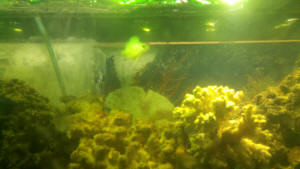 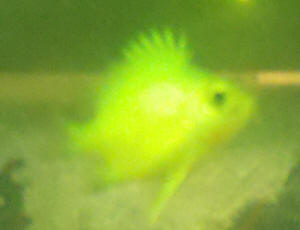
|
|
Chromis flavicauda in the Indian Ocean??
6/19/10
Hi,
<Hello>
Here in India we get a species that looks exactly like the
*Chromis flavicauda. *Is there an Indian ocean variety of this
fish?
Daniel Naveen K
<Mmm, there are members of this genus found in the I.O., but
likely, color-wise you're referring to a Chrysiptera sp.,
perhaps C. arnazae:
http://fishbase.mnhn.fr/summary/SpeciesSummary.php?id=65465
Bob Fenner>
Re: Chromis flavicauda in the Indian Ocean??
716/10
Hi,
I got a picture of the fish. Hope this helps for a more accurate
ID. My LFS says these are *Pomacentrus caeruleus.*
<Likely so. BobF>
Regards
Daniel Naveen
|
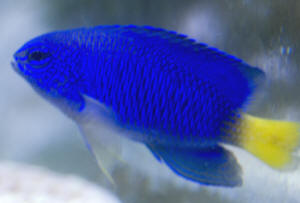 |
|
damsel id 5/25/10
Hey everybody! I have a quick question concerning the
identification of a damselfish I recently bought searched and
searched for anything that somewhat resembled it and came up with
a picture off of your website. This
particular fish is amazingly fast so therefore I couldn't get
a good snap of it. I was told it was a scissortail damsel but I
haven't found anything remotely similar to what this fish
looks like. I also looked on fishbase.org but to no success. Any
help would be appreciated.
<!? Do take another look here:
http://www.fishbase.org/Summary/FamilySummary.php?ID=350
on Fishbase... the link at bottom left, "Show Species",
will bring up their nominal photo per species... Otherwise, a
trip to a large (college) library to peruse the Pomacentrid works
by Gerald Allen... Your pic is too blurry for me to place. Bob
Fenner>
|
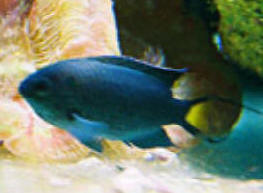 |
Pomacentrus alleni ID 1/20/10
Hello,
<Hello Mike>
I am wondering what you would consider a "defining
characteristic" for P. alleni. My LFS 4 fish in that I believe are
P. alleni, but he has them labeled as something else. I want the P.
alleni because of their more docile nature and don't want to make
the mistake of introducing a different damsel into my tank. These fish
are neon blue with some yellow around the anal fin.
<Hence the name, Neon Damselfish.>
They DO have the black stripe on the bottom of the caudal fin. Does any
other damsel have this feature, or is this a good indicator that they
are in fact P. alleni?
<Without a pic, your description sounds like the Neon Damselfish,
and I do not understand why you are writing as this information is
easily found by Googling.
Take a look at the attached pic for comparison.>
Thanks,
<James (Salty Dog)>
Mike
Pomacentrus alleni Query
Hi Bob,
I put this query into the emails with image but it is not my image,
just sent to querior for reference. I know you do not use other peoples
work on your site for good reason so I just want to give you a heads up
on this.
James
<Real good. Thank you, B><<Mine's here: http://wetwebmedia.com/pomacentrus.htm>>
|
Re: Mystery white stuff? Now Damsel ID
10/9/2009
Thank you again Mike. Will put all your suggestions into
practice.
<Hi Liz. Good to hear.>
One last question for you. Any idea what kind of damsel this is
(see attached picture)? It came with my tank, previous owner had
no idea what it was.
<Damsels can be very tricky to identify. The cute little
colorful fish you buy in the store usually morphs into something
that looks much different when it grows up.>
It's color changes from a dark blue/purple to a washed out
various of the same as it swims around the tank. Very personable,
busy fish. Has staked out it's corner of the tank and is
otherwise very tolerant of the two pesky Sgt. Majors and
isn't concerned at all with the Cardinals.
<Really need some more information to even attempt an
identification better than a guess. Information like size and how
long one has had the fish is helpful. Many damsels change their
colors as they mature. If one were to force me to make an ID, my
best guess would be a member of the Neoglyphidodon genus that is
in the process of color changing.
http://www.wetwebmedia.com/neoglyphidodon.htm >
It does do something odd with the eel. I've noticed several
times when the eel sticks it's head up out of the rock at the
back of the tank the Damsel will swim over, invert its self so
it's head is pointed straight up towards the top of the tank
and then stay there by the eel. Sometimes still, sometimes
'wagging' it's hind end. I assume this is some sort
of posturing, but it doesn't seem real aggressive. The eel
isn't bothered by it at all!
<Posturing because the eel is too close to the damsels
territory is most likely.>
I sure wish I knew someone like you locally. I have *so* many
questions.
<Do have a look on this page -
http://www.wetwebmedia.com/damsels.htm Has links to the different
types of damsels
Take care,
<Will do>
Liz
<MikeV>
|
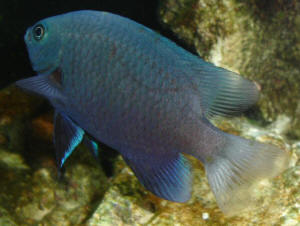 |
|
Re: Mystery white stuff? Now Damsel ID
10/12/2009
Wow,
<Howdy Liz.>
I had no idea damsels could color morph so amazingly.
<Yep. Unfortunately, they usually become very drab as
adults.>
Sadly, I don't have much background info on the fish. It came
with the tank when I bought it and the precious owner didn't
know what it was either.
Which kinda stymies me. I've been obsessively cataloging and
identifying everything large and small living in my tank.
<Understandable.>
Here is what I do know about the fish:
- about a year to a year and a half old
- 3 1/2" long excluding tail fin <Close to being an adult
then.>
- in the tank the color of the fish changes pretty dramatically
as it swims.
Sometimes it looks very vivid (like in the picture), sometimes it
looks like a washed out version of the same colors. Just depends
on how the light hits it.
<Or the fish's mood.>
Not much to go on. I suppose specific ID isn't critically
important, but I do like knowing what I have when possible!
<Do keep digging around - http://www.fishbase.org is an
excellent reference as well.>
Thanks,
Liz
<MikeV>
|
|
Unknown damsel
<Mmm, your image files... are too dang big Scotter!>
Inherited this from a guy getting out of the business. Can you
tell me what type of fish it is? Assumed it was a damsel...
possibly cyanea? Just not sure. It's a deep blue in color and
about 3.5 to 4 inches long and they said they had it about 5
years. Any information would be great!!!
Scott
<Looks to be some Stegastes sp. See here:
http://wetwebmedia.com/stegastes.htm
and fishbase.org... Allen's works...
BobF>
|
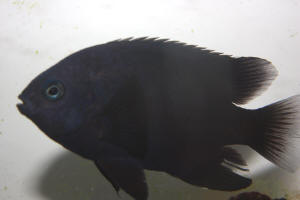
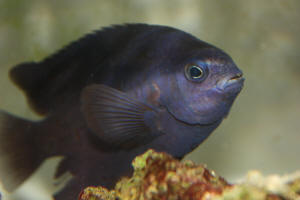 |
|
Fish ID 06/08/09
I was given my first saltwater aquarium a few weeks ago, with
fish by a friend. She went bigger and gave me the fish that came
with her tank bigger tank. I have identified all the fish in the
tank except for this one. I was finally able to get a couple of
good clear photos of it and have attached them to this email. It
is approximately 2-2 1/2 inches long and is always these muted
colors.
Thank you, Julie
<Hi Julie. Chrysiptera rex, the spot behind the eye in
combination with the coloration (which can be more vivid on other
specimens) is typical. Cheers, Marco.>
Re: Fish ID
Thank you so much. We knew it was part of the damselfish family
but couldn't figure it out. You guys are awesome. Julie
<Thanks for your kind words. Marco.>
|
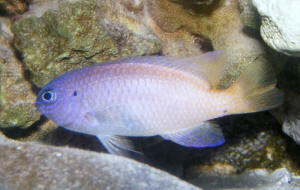 |
Damsel ID 4/6/09
Maybe y'all can help me. I've acquired a little damsel fish
that I'm having a heck of a time identifying. I am sorry that I
don't have a photo but I'll try to give as much information as
I can. The fish is about 1"
from head to tail with the tail not split into two. It has a background
color of silver/pale white with the bottom fins colored yellow. There
is a blue part of the body extending from the nose along the top to the
dorsal fin. I've looked all over fishbase.org and queried the
internet without any luck.
<There are too many fish in that family for me to even guess what
you have without a pic. Do provide a pic and I'm sure we can ID
this fish for you.>
Thank You!
<You're welcome. James (Salty Dog)>
Charlie Purkins
|
Fish ID: Not likely to be a Goatfish. WWM Crew, any
other input? 3/20/2009
Dear Sir,
<GrüÃe Karl-Heinz>
I collect since 40 years fish on stamps. Now I have a
problem.
What´s the scientific name of this Goatfish? You can
help me?
<I examined the original stamp here:
http://www.unicover.com/H0005081.htm I believe the artist made
some sort of mistake, or this is a typographic error on the
page.>
<Ich untersuchte die original Marke hier:
http://www.unicover.com/H0005081.htm. Ich glaube, dass der Artist
Fehler machte, oder das ist ein typographischer Fehler auf der
Seite.>
<It is difficult to determine from the picture what kind of
fish it is, but it is not a Goatfish. The fish in the picture has
one long dorsal fin and no chin barbels, rather than two separate
dorsal fins and two barbels on the chin which is a characteristic
of Goatfish.>
<Es ist schwierig, vom Bild zu bestimmen, welcher Fisch es
ist, aber es ist nicht ein Meerbarbe. Der Fisch im Bild hat eine
lange Rückenflosse, und keine Kinn-Barben, aber nicht
zwei trennen Rückenflossen und zwei Barben auf dem
Kinn, das eine Eigenschaft von Meerbarbe ist.>
Thank you very much for your trouble.
Regards from Germany
<Mit Freundlichen GrüÃen von Florida>
Karl-Heinz
<Mike>
Fish on stamps, RMF 3/20/09
Dear Sir,
I collect since 40 years fish on stamps. Now I have a
problem.
What´s the scientific name of this goatfish? You can
help me?
<Mmm, looks to be a Damsel of some sort (Pomacentrid)...
Perhaps a stylized Chromis species.>
Thank you very much for your trouble.
Regards from Germany
Karl-Heinz Dau
<Velkommen. Bob Fenner>
|
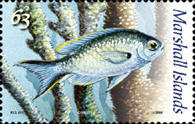 |
Fish on stamps 3/20/09
Hello,
thank very much for your answer. The post office from Marshall
Is. say it is a goatfish. Okay
<Javul! I have seen some real doozies... Even invertebrates
with fish names! BobF>
Fish On Stamps 3/21/09
Hi Bob,
Isn't Velkommen Danish for welcome and willkommen German for
welcome.
Just curious as the gent is from Germany. I spent three years in
Germany and never heard the term Velkommen. Keep in mind I'm
not being a smart ass, just curious.
Jim
<Ja! Is a stmt. re my impoverished language skills... A friend
of mine oft responds when spoken to in Mexican in whacky
imperatives... Understanzee?
B>
Ahh.
auf wiedersehen,
Jim
<So long, fare... and you and you and you. B>
|
| Damsel? 08/08/2008 Hello, Could you please
identify this damsel for me? <<Had to speak to Mr Fenner on
this one, certainly not one I have come across before. As per his
thoughts, Neoglyphidodon bonang, and this one being a juvi of this
species. Please do search on fishbase.org for the above.>>
Thanks! RJ Duco <<Hope this helps, thanks for the question. A
Nixon>> |
|
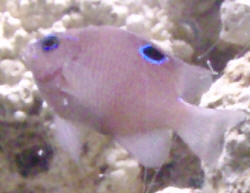
|
Damselfish ID Help 06/05/2008 Hello Lords of
Everything Fishy, <<And Ladies....Andrew with you
today>> I was hoping that you could help in the
identification of a newly acquired damselfish. My fish guy is
trying to get out of the business and gave me three turbo snails,
what I think is an Amblygobius phalaena, and the damsel in question
for only five bucks. I could turn him down. He told me that it was
a blue-green chromis; although it looks nothing like any that I
have seen. Most of the time it appears black or really dark blue
with a striking yellow stripe down each side of its back. It also
has a small yellow dot just after the strip on each side. It is
about 1-1/4 inches long. I have attached a picture. <<Ahh
yes, indeed a Chromis, common name Orange line Chromis>>
Thanks, CM
<<Thanks for the question, hope this helps. A
Nixon>> |
|
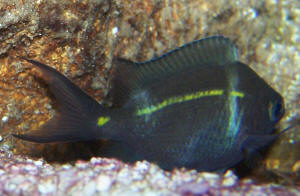
Actually Acanthochromis polyacanthus, a
really neat neo-tropical cichlid-like breeding Pomacentrid.
RMF.
|
| Juvenile Damsel in Transition- or Adult In Full Bloom?
Damsel ID) 05/11/08 Hi crew. <Hey there! Scott F. in
tonight!> Hope you are all well. I was wondering if you could ID
this Damsel for me, please. Sorry the picture is great. Thanks Ben
<Well, Ben- it's not as easy as you might think! I'm
pretty confident that it's in the genus Pomacentrus, but I
can't nail down the exact species. It has an ocelli (eye spot)
at the bas of the dorsal fin, which is found on many Pomacentrus
species as juveniles, and several others as adults. If it's an
adult, I'm leaning towards the rather obscure P. adelus, but it
might very well be an juvenile of any number of species in the
genus. Might be easier to identify later if this fish is, indeed a
juvenile Hope this helps point you in the right direction! Regards,
Scott F.> |
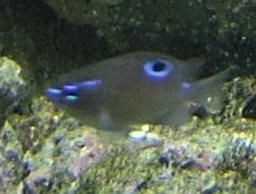 |
Damsel ID 1/22/08 Hi there, <Hi Rob> Great
site, I use it as a reference, often. <Thank you.> I have a
question about a damselfish I saw yesterday at my LFS. I couldn't
seem to find it on fishbase.org. There were some that were close but
not really. The fish is about 3/4 inch in length, is reddish-orange
color over all and has a single blue ring on it's back. It has a
body is shaped similarly to the Pomacentrus. There are no stripes or
additional spots anywhere else on this fish. The store has it listed as
a red damselfish. I don't think they knew what they were when they
came in so they listed them based on their coloration. I assume that
they are a juvenile form and I am curious on what it's mature
coloration will be. I wish I could be more detailed but it isn't a
very elaborately colored fish, just different from the usual damsels I
see here. I don't believe it's a juv. garibaldi, color is
wrong. I have been in this hobby for almost 20 years and I have not
seen anything like this fish and I would like to get one. Any ideas
would be helpful. <Without a pic...I'll take a stab. Could be a
juvenile Pomacentrus bankanensis or vaiuli.> Thanks, <You're
welcome. James (Salty Dog)> Rob Mancabelli
| Damsel? ID…? 9/26/07 Hi All, <Hi
Reuben, Mich here.> It's been awhile- my FOWLR is great
<Good to hear!> (though my miniatus and trigger did have to
be separated for now; the grouper outgrew the others quickly and
tried to have a Huma snack). <Yikes!> I started a reef system
a couple years later and cycled it with a few a damsels who still
reside there. <For future reference is best to do fishless
cycling.> My question is related to one of these fish- I
purchased it because it was mixed in with the damsels at my LFS and
I had never seen one before (or again). I have been unable to
identify or even find another photo of this fish on your site or on
the Internet in general, but then I'm not sure if I'm even
looking at a damsel. <Looks like a member of the Pomacentridae
family to me.> It doesn't really seem 'damsel-like'
to me in terms of behaviour- it doesn't really have a specific
territory, it just swims around in the open all the time, like my
Chromis. It's not aggressive at all. <May or may not be
characteristic of the species.> It also has a sort of elongated
body compared to other damsels I have seen and it is very small,
only about an inch though I have had it for three or for years. I
finally got a digital camera and was hoping you could put my
curiosity to rest. I assume it is a damsel, but I can't stand
not knowing for sure. I like to know the Latin name for everything
under my care (my yard is labeled, my herps are labeled, my birds-
I may tattoo my wife next, <Look out!> despite my being under
HER care). <Ahhh, an honest man.> Can you tell me what I
have? <Is difficult to determine from just one pic. I can't
tell from the photo if the background color of this fish is blue or
black. Perhaps this is a member of the genus Pomacentrus, there are
some 241 species in this genus alone and over 321 species in this
family. I would recommend spending some time on www.fishbase.org
http://www.fishbase.org/NomenClature/ScientificNameSearchList.php?crit1_fieldname=
SYNONYMS.SynGenus&crit1_fieldtype=
CHAR&crit1_operator=EQUAL&crit1_value=pomacentrus&crit2_fieldname
=SYNONYMS.SynSpecies&crit2_fieldtype
=CHAR&crit2_operator=contains&crit2_value=&group=summary&backstep=-2
> Thanks for making your vast knowledge available! <Wish I
could be more help here.> Reuben <Mich> p.s. Sorry if the
pic is large, I'm not sure how to resize them yet. <Is fine.
We recently upgraded our web mail system and can handle bigger pic
without it crashing our server like it used to.> |
|
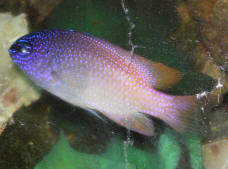 <Perhaps a juv. Chrysiptera. RMF> <Perhaps a juv. Chrysiptera. RMF>
|
| Damselfish ID? (N. nemurus or N. azysron) 3/4/07
Hi Bob (et. all), <GrahamT with you tonight, greetings to
you.> Since I got such a quick response to my last question, I
thought I would pose this one again. I tried once before, but I
didn't get a response. Maybe I sent the picture wrong? <Who
can say? We are not without our quirks; both personal and with our
email server... ;) > Any help would be appreciated. <Will
try...> Jim Subject: Damselfish ID? Hi Crew! Hope you're not
getting as much snow wherever you are as we are here in Ohio! I
don't want to be guilty of requesting help on an easily
identifiable fish, but I have looked everywhere I can think of, and
I am still not sure about this one. I picked it up at a nearby fish
store as an "assorted damsel" (got two, in fact, but only
one made it). This is the best picture I could get... he's a
fast little bugger! <Know the feeling...> I figured it was
some kind of Chromis I had never seen before, but I don't think
so. Maybe a juvenile Neopomacentrus violascens? <Doesn't
convince me...> I don't know how different they look when
young. Or perhaps a member of Pomacentrus? <That's possible,
but...> Looks a lot like Pomacentrus nigromanus, but a lot
bluer, and the yellow doesn't go as far forward dorsally. <I
agree - no match. How about Neopomacentrus azysron ( http://darwin.zoology.gla.ac.uk/~rpage/ispecies/?q=Neopomacentrus+azysron
)? I think this one to be more likely, since they are usually
characterized by their solid yellow caudal fin. Or Neopomacentrus
nemurus ( http://darwin.zoology.gla.ac.uk/~rpage/ispecies/?q=Neopomacentrus+nemurus&submit=Go
)? I think these are the closest matches for you, but it *is* hard
to tell by the picture. > I guess it's really no big deal,
but my curiosity is killing me! <We understand. Oh yes, we
understand.> Thanks again, Jim <Welcome, Jim. -GrahamT P.S.
Thank you for the reasonably-sized attachment. We all appreciate
it!> |
|
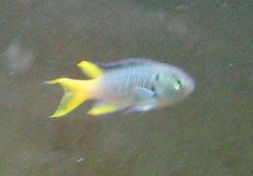
|
Damsels Will Be Damsels...! 9/30/06 Hi! <Hi there!
Scott F. here today!> I just set up a new 29 gallon BioCube tank (my
first tank) and when the tank was ready for fish, I bought a Hi Fin
Goby and a wild-caught Percula Clownfish. After two days the clownfish
jumped into the filter system along the back of the tank and died (the
goby jumped the back of the tank too, but he came through OK).
<Yikes...sorry to hear about the Clown.> I put up a plastic
barrier to prevent this from happening again and ordered a tank raised
clownfish from the LFS. <Good moves.> In the mean time, I bought
a Yellow/Golden Damsel to help "feed" the live sand and rock.
He's very fun to watch (my cats love him) and both the Goby and
Damsel are eating well. They've been together for a few days and at
first it didn't look like the Damsel was chasing the Goby or
exhibiting aggressive behavior, but yesterday I noticed that the
Goby's "hi fin" had been chewed down. Will the Goby's
fin grow back on its own or is there something else I need to do to
make sure he's OK (i.e., add vitamins or antibiotics). <In all
likelihood, the damaged fin will grow back. However, you do want to
keep very stable, clean water conditions to prevent the possibility of
infection. Also, I'll be that the Damsel had something to do with
this fin damage...And it may be repeated as long as the Damsel is in
the system!> What should I do about the damsel? I would ultimately
like to get a Royal Gramma and/or Spotted Mandarin to go with the Clown
and Goby, along with some coral and inverts. Will the damsel be too
much of a problem in this mix? <Quite probably. Damsels of many
species have a well-deserved reputation for aggressiveness. I'm not
sure which species you have (a number of different species go by the
common moniker, "Yellow Damsel", so pics or a scientific name
would help, but it's almost always a safe bet to assume the worst
(in regards to aggressiveness) when keeping these fish!> Any help
would be greatly appreciated! - Linda <Well, Linda- I'd consider
either not adding the more peaceful fish that you are considering, or
perhaps setting up a new tank for the Damsel to rule! Good luck!
Regards, Scott F.>
Damsel ID - 02/27/06 Could you please identify this ugly
fish for me that I have had for about 4 years, and is the bully of
the tank? Unfortunately, I have 3 of them! They are such bullies!
Bullied my Tank and now Clarkii Clown to the point of death.
<Pretty sure this is Amblyglyphidodon aureus: http://wetwebmedia.com/amblyglyphidodon.htm and see the
pix on fishbase.org as there is considerable variation. Bob
Fenner> Thank you!!
Pam |
|
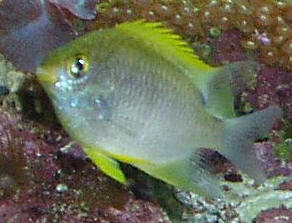
|
Black Cap Damselfish info... ID 2/14/06 I just recently
purchased a Black Cap Damselfish from my LFS and cannot locate any info
on the web regarding this particular Damselfish. Any suggestions?
<Mmm, this descriptor doesn't come to mind, nor come up in a
Google search, on/off WWM, nor fishbase.org... You can read through
these resources by family (Pomacentridae... there are some 375 or so
species though)... there are a few damsels that bear a "black
cap". Bob Fenner> Damsel ID 7/20/05 WWM and Crew: First
and foremost, thanks for this site! No aquarist should be without it,
especially us pseudo-beginners! <Are there such folks?> If you
have time, I need some help with a damsel ID. I went to the LFS
yesterday with the intent of buying some blue-green Chromis, and of
course they had none. In the tank labeled "Green Chromis"
(which he certainly is NOT), there was this cute lil bugger that I
couldn't identify. He is the exact same size and shape as the
yellow-tailed blues next to him, and I assume he was mistakenly shipped
with them. I know I shouldn't buy fish (especially damsels) that
I'm not familiar with, but he was just too interesting. On to the
description: He is tannish/pinkish, to almost purple...sometimes (he
seems to change a lot). He has a clear caudal fin, and blue-tipped
pelvic fins. On his dorsal fin is a black spot, surrounded by
iridescent blue. I've looked all over the internet, and the closest
I can come are these: one-spot damsel, obscure damsel, Indonesian
damsel. Any idea? <From your description, could be one of these>
I'd like to be able to research him, but can't find much info.
I'm desperately hoping he doesn't become a holy terror! TIA,
Jodie Bivens <Please send along a pic or two if you can. Bob
Fenner>
Damsel ID 7/20/05 Bob... when you get a chance, could
you peek at this fish for me? <Hey big boy!> Trying to get an
ID on it and got lost on fishbase, etc does Acanthochromis ring a
bell? <Nah, the neotropical cichlid wannabe? Tis an
Amblyglyphidodon leucogaster See here: http://www.wetwebmedia.com/amblyglyphidodon.htm> I saw
it was monotypic but this fish looked similar?
Ant-
<... BobF> |
|
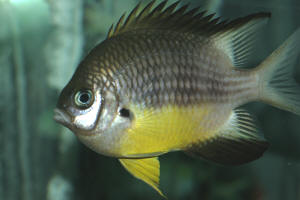
|
|
Re: damsel ID 7/20/05 wow... how cool! As I
was searching among pics and words on fishbase... I kept coming
up (and ignoring <G>) hits on cichlids! way cool. Thanks so
much, bro. :) <Welcome. B>
|
Hawaiian Damselfish My local aquarium store has a
damsel that I have never seen before. It is listed as a Hawaiian White
Damsel and sells for $19.99. I am trying to find out some information
on its care, behavior and adult size. I looked at the white damsel
listed on your site and I am not sure if it is the same. Can you give
me some insight? Caryn < Take a look at a Hawaiian damselfish by the
scientific name Dascyllus albisella on fishbase.org. It feeds on small
invertebrates and gets about 5 inches long.-Chuck.>
20 ga. Filtration & Stock Hello, <Hi there> I
kept a 20ga saltwater tank several years ago, but took it down when I
moved out of state. At that time, filtration consisted of an
undergravel powered by the intake of a Skilter 250 that hung on the
back (the Skilter's intake tube was inserted into the undergravel
lift tube). <We've come a long way baby> I started this tank
up again a few weeks ago in my new home and would appreciate some
feedback. <I'd look around re gear upgrades... get a bigger
tank...> I've added a Marineland Eclipse2 hood this time
(cartridge/bio-wheel setup), and am also running the undergravel with a
strong powerhead for additional filtration and aeration. I have not
employed the Skilter this time because the tank's new position is
such that it can be viewed from all four sides, hence I am trying to
avoid "hang on" parts. <Mmm, might add a sump/refugium,
remote a/the skimmer there...> The tank is fish-only and contains no
live rock. The only inhabitants at this time are a tiny yellow-tail
damsel and a flame angel. <Too small a volume for the latter> I
anticipate eventually adding one, maybe two more small fish at most.
Possible future inhabitants might be a six-line wrasse, either a
bicolor or a purple Pseudochromis, or perhaps some type of clown
(although I am reluctant to subject most of the little guys to life
without an anemone). <Mmm... too much to say that has already been
written, recorded on our root web here... I would read before making
these additions... assertions> I would very much appreciate your
feedback regarding both my filter system and the potential additions to
my community tank. <UG filtration can work, as can small (less than
forty gallons, my arbitrary number) systems... but Flame Angels, more
than one damsel... not a good bet. Do read over on WWM re the
possibility of adding external gallonage at least, keep in mind maybe
making the 20 itself into this to service a larger tank. Welcome back
to the hobby. Bob Fenner> By the way, can you tell me the true name
for the yellow-tail damsel? I've seen various sources call it
Chromis xanthurus, Chrysiptera parasema, and
Chrysiptera hemicyanea. Which is correct? <Please see here:
http://wetwebmedia.com/chrysiptera.htm.
Chrysiptera cyanea is by a large margin the most common
"Blue Damsel", though other Blue (Chromis viridis
principally) are sold as such. C. parasema is the most common
"Yellow Tail Blue Damsel", though there are other species
sold as such regionally, seasonally... C. hemicyanea is rarely
offered in the trade.>
The Vagaries of Damselfish Taxonomy (4/4/05) Hello
crew! <Hi. Steve Allen with you tonight.> I am a little confused
with blue damsel classification. <You're not the only one.>
As far as I know (correct me if I am wrong) Chrysiptera cyanea is a
blue damselfish with black stripes on the 'face' and a nice
black dot at the base of the spinal fin. This dot is quite far from the
edges of the fin (~1-2 mm). Adult males develop orange tail and go
under the name of "orange-tail damsel" while still having the
dot. As far as I understand juveniles all have this dot? <There
seems to be some disagreement as to what this species is on different
sites. I would call this definitive:
Chrysiptera cyanea > If there is a dot at the base of the spinal
fin, but at the edge of the fin, is this a different species? How you
can distinguish the Pomacentrus coelestis (or Dascyllus coelestis?)?
Chrysiptera springeri ? Abudefduf assimilis (or Abudefduf cyaneus?)? Is
the coloration dependent on collection place? <Color morphs do occur
within single species based on location and other factors. Also,
classifications can be changed over time. I'd suggest you go to
www.fishbase.org and search on
the species you listed. There are also ways to search there based on
characteristics.> <<Editor's note: Often special
differentiation is determined via ray count of unpaired fins,
etc.>> Can fish collected from different ecosystems be
interbred? (assuming the same scientific name) <Presumably, since
they must be able to breed in order to be in the same species. Some
close species interbreed, which leads to hybrids that may or may not be
able to reproduce -- just like the mule, which is a cross between a
horse and a donkey that cannot reproduce.> Thanks a lot for your
help. Sincerely, Rony. <I hope this helps.>
Damsel ID Hi Bob, <James for Bob today> I bought
a damselfish a couple of days back and I'm hesitating to include it
into my system. Reason was because I could neither ID in your website
nor any other. Would you be kind enough to help me. Please find
attached picture for your reference. <Email w/photo not
found> <Not a real good pic to ID, but from what I see, it
looks like a member of the Dischistodus genus. Here is a link with
photos on the damsel family. You may be able to make a better ID since
the fish is in front of you. Well my copy/paste isn't working
again, but type in the keyword Damselfish and take a look there. James
(Salty Dog)>
Chromis and damsels Hi again, << Hi there.
>> Sorry to be a pest, but I have been reading you site for about
6 hours now and have stumbled upon your damselfish and Chromis. Might
be a stupid question but are they the same species? << Chromis
are a type of damselfish. >> I have been told that mixing damsels
with my Chromis was a bad idea, but I have been fascinated with the 4
stripe damsel. << I have no idea why anyone told you not to mix
them. I think they do great together. Both are very easy to keep, and
make great beginner fish. >> Can they go with the fish I
currently have in my tank or are they too aggressive? Thanks for your
help on the first question. << Many damsels, like the 4 stripe,
are quite aggressive. Therefore many hobbyists stay away from them.
However, they are easy to keep and great beginner fish. >> Cierah
<< Blundell >> New Damsel species? Hi gang:
<Chuck> My LFS recently stocked some fish labeled "Blue reef
Chromis". They were a beautiful electric blue. . . with fully
developed, almost exaggerated lyre tails. . . and a bit of black up
around the dorsals. Probably 4-1/2 inches from stem-to-stern.
<That's a larger species!> I've never seen these at any
of the stores/importers in the LA area. . . and don't remember them
from any books. They seemed to school. . . maybe not so much as the
common 'green' Chromis. . . and it was hard to be sure in the
heavily stocked display tank they were housed in. I assume these are
some sort of damsels. Any comments on these critters' behavior
and/or special needs? Is that wonderful blue color likely to survive in
captivity? Even if they're reef compatible and not too aggressive,
I'll have to wait till I see them available again: The half dozen I
saw were sold out in no time. Chuck <Time to send you through a
search of our Damsel coverage: http://wetwebmedia.com/damsels.htm
Take a look through the pix there... and on to Gerald Allen's works
if you don't see it. Bob Fenner>
Help with ID please? <Hi Ed, Mac here>
http://www.reefaquariumguide.com/photos/data/500/10283purpledamsel-med.JPG
Here's a link to a new addition to my tank that I haven't
been able to Identify. Any ideas? <I believe you have a
Chrysiptera springeri there Ed. I've gone through the entire
list at fishbase.org and through the burgess book and that's
really the best fit. Very nicely colored and very nice picture.>
Thanks,
Ed Byron |
|
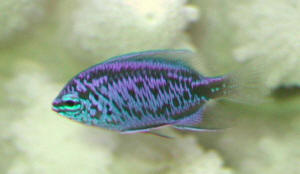
|
ID a fish, please 2/6/04 Here's another picture I just
took Paul. You know, I think you are right about them being Damsels,
only because I remember them being so cheap! <From the look of the
picture it looks like it is Amblyglyphidodon
("Am-blee-gliph-id-oh-don") damsel! See the similarities
here: http://www.wetwebmedia.com/amblyglyphidodon.htm>
But now, I just want to get rid of them. They're not very
attractive. <Not so bad, me thinks> I'm going to the net now
to look up the Leucetta sponge. Thanks for chatting with me! <Thanks
for being part of it all ~Paul> Pam
|
Neopomacentrus azysron? (damsel id) Hello
folks-<Hi Steve, MacL here> I hope you have patience for
one more Damsel ID query-<Always and this was an interesting
one for me.> Does this resemble Neopomacentrus azysron? <It
does very closely resemble it. However, and azysron is
characterized by a solid yellow tail. Sadly i had to rule that
out since yours has the blue or black lines on the tail.>
Happy to say it's been very happy in my tank for more than
two years- frustrated that I can't quite nail the id after
many web searches. <I must say I have gone around and around
with it myself. Some of the other crew feels it is a
Neopomacentrus cyanomos (The "Regal Demoiselle"). I see
similarities with the Crescent or regal damsel but if it is its
not from the indo-pacific but instead from another area and might
possibly be a color morph. Indonesian fish metallic green to
black with a distinctive white spot at end on dorsal fin base.
That's not your fish at all. However there are a couple of
pictures that are similar to it when you click on the fishbase
picture.> It displays what appears to be non-hostile
(flirtatious?) fin-splaying behavior around my GSM female; even
huddles with my GSM pair when frightened. About 3", not
counting the long streamers on the end of its tail- just a bit of
yellow on the inner part of the tail and bottom fin- not as much
as appears on fishbase specimen photos- any ideas? thanks very
much! <Personally I think it might be a cross of some kind.
But that's just my opinion. Take a look at the regal or
crescent damsel in www.fishbase.org and see what you think.
MacL>
|
|
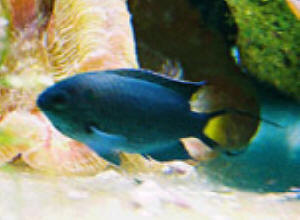
|
A What Kind of Damsel? >I purchased four of these and was
told that they were deepwater Indo-Pacific and they will get big. They
look like Anthias fish. Is there a good site to find out more on them?
thanks, BB >>Not that I can find (doing the usual Google and
fishbase.org searches). You'll do well to search http://www.fishbase.org on your own to
find something that matches, as this is a completely unknown (or
un-findable) common name. Otherwise, treat as damsels. Marina
Re: Fiji damsel >Hi Marina (and crew of course)
>>Good morning, Connie! >I read your response today to someone
telling them about one of your fishes, a Fiji damsel. I have checked
all the suppliers on line that I know about and haven't found any
info. Could you tell me where you acquired this pretty fish???
>>Oh my, that would have been Bob's department, as I'd
never seen the fish until I worked with him some ten years ago or so.
They came in a shipment he'd ordered, but I'm going to do a
quick search and see what I can find. Ok, so far I'm finding that
the pink and yellow damsel I have been calling "Fiji" is
something else entirely from what most others are calling
"Fiji"! O! Lament the common names! But I'm not finished
yet. >Thanks so much for your help, Marina. Connie
>>You're welcome, now let's see what I can find for you!
Here's something close, but it's not the same fish
http://www.fishbase.org/Summary/SpeciesSummary.cfm?genusname=Neoglyphidodon&speciesname=nigroris
>>Here's a pretty one, but not the one I was talking
about...BOB! LOL
http://www.fishbase.org/Summary/SpeciesSummary.cfm?genusname=Chrysiptera&speciesname=bleekeri
>>This one demonstrates the posterior dorsal fin spot, but on the
animal I'm thinking of it wasn't ringed, still, beautiful
http://www.fishbase.org/Summary/SpeciesSummary.cfm?genusname=Pomacentrus&speciesname=vaiuli
>>
http://www.fishbase.org/Summary/SpeciesSummary.cfm?genusname=Chrysiptera&speciesname=rex
>>Well, that's it for my search. We'd have to ask Bob if
he remembers this little fish at all, because I've now spent the
better part of 45 minutes with no luck finding the exact fish I
remember, nothing even *quite* close. I am very sorry, too! Marina
|
A Question (What else?) (Damsel identification) Hello,
I was wondering if you could properly identify the black and
yellow striped Damsel pictured on this page
http://www.fishsupply.com/cgi-bin/common/art_viewer.cgi?item_no=FDH00
I have never seen this damsel before and when I research the
scientific name supplied with the picture (Pomacentrus coelestis
), it is always listed as the common blue and gold Damsel.
Thanks, Rich <This is a Neoglyphidodon. Please see here:
http://www.wetwebmedia.com/neoglyphidodon.htm and check the
juvenile coloration phase by the name on fishbase.org Bob
Fenner>
|
|
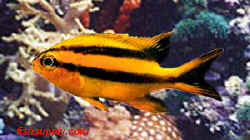
|
TWA Damsel i.d. I'm not sure if your
organization offers assistance like this, but thought I'd try
anyway. I am trying to identify the fish shown in the attached
picture. I took the photo in May 2000 while diving off the coast of
Antigua . I've gone through various fish identification
references, but haven't found a match yet. I thought it might
be some sort of damselfish. Any help you could provide would be
appreciated. <It is a Damsel, likely Stegastes planifrons.
Please see here: http://www.wetwebmedia.com/stegastes.htm Bob
Fenner>
Thanks, Jared |
|
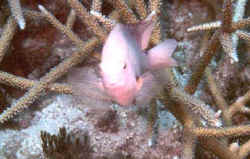
|
Damsel ID/Info I hate to even ask this without a pic, but my
LFS got in some damsels that I had never seen before. <A good photo
is a tremendous help...but...I'll hazard a guess anyway> They
look exactly like the pic on your site of Pomacentrus chrysurus, but
their bodies show no blue (they are approximately the color of the
brown stripes on a Dischistodus prosopotaenia). <Many of the
damselfishes in the Pomacentrus genus are blue...but not the critter
that you specified> Could these be stressed/juvenile Pomacentrus
chrysurus? <Not IMO...I am going out on a limb and venturing a
semi-educated guess at what you have seen: I think it is the adult
Pomacentrus chrysurus or...how about an alternative?...a
Plectroglyphidodon lacrymatus damselfish. That's "fancy fish
talk" for a Jewel Damselfish. The Jewel is an olive green/brown
fish with a few colorful spots along the head and the dorsal fin area,
thus the "Jewel" in the common name> The guy at the LFS I
spoke to said that they didn't like getting them in because they
had such a high mortality rate; is there any cause for this?
<Really? Interesting <G> I think I would try a different
supplier for these fish. Normally, damselfishes are one of the toughest
fish that you can buy. They are very disease resistant, particularly
Pomacentrus. I hasten to add that wild-caught clownfish (Amphiprion and
Premnas) are often imported with parasites/disease but are hardy once
established in a stable system.> I've been through the
Pomacentrus article and FAQ and I couldn't find any specific info
about behavior/feeding/etc. of Pomacentrus chrysurus. <Well for
starters...Remember that nearly all damselfishes are quite territorial
and have the potential to harass their own kind as well as other more
peaceful fish. If you have a large tank you can house an odd numbered
school of damsels (Pomacentrus) but if your tank is small (under 55
gallons), just one. Feeding is easy...they are carnivorous and
herbivorous. They will eat and stay healthy by consuming meaty items of
marine origin as well as picking at whatever algae is growing in your
tank> If you could share any info you might be privy to, I would be
grateful :). Thanks, Laura <You are very welcome. I hope I've
helped...David Dowless>
Jewel damsel I recently purchased a Jewel Damsel. Upon doing
more research on the animal, however, I have discovered that there are
actually two different types of Jewel Damsels, with species names
Plectroglyphidodon lacrymatus and Microspathodon chrysurus (Atlantic
Jewel Damsel). After reading your article I understand that the latter
gets quite large. I do not want this for my tank. I've looked at
pics for both, and I cannot seem to tell them apart (at least when they
are juveniles). Can you give me any help here. Many Thanks, A <Mmm,
they're both pictured and described on WetWebMedia.com and
fishbase.org... As juveniles M. chrysurus is much more brightly colored
and it is by far more common in the hobby than the Pacific damsel. Bob
Fenner>
Re: jewel damsel Thanks Bob. I've come to the conclusion
that it is Microspathodon chrysurus. I have netted it and hope to bring
it back to the fish store. It was quite the terror. <Yikes... this
species can be VERY territorial.> Netting it was a whole adventure
in and of itself.....suffice it to say that it took a krill soaked in
garlic supplement and a very large net. _A <Yum, now I'm getting
a tasty chemical memory. Hope that's not a large net I see in the
kitchen! Bob Fenner>
|
|

